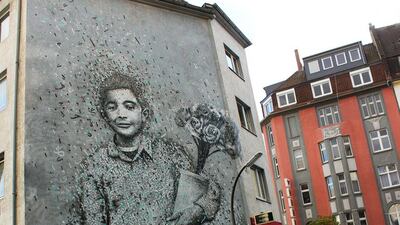Syrian flower seller Fares Al Khodor was a familiar sight on the streets of Beirut.
With his wide smile, slicked-back hair and buckets of roses, the cheerful little boy roamed the pavements and bars in the Hamra area, sacrificing his education to help support his family after they fled Hassakeh in 2011.
In July, he returned to Syria for a visit and was killed in an air strike, at the age of 12.
Today, his face smiles out at passers-by from the side of a four-storey building in Dortmund, Germany, where he has been immortalised in a mural by Lebanese street artist Yazan Halwani. The latest in a series of portraits by the 22-year-old artist, the painting aims – like all of his murals – to foster a sense of community.
In Germany, it encourages people to reassess their views of refugees. In Beirut, his work has an even more ambitious aim – to unite a population that has been fractured along sectarian and political lines for decades.
“What I try to do is propose things that might change the landscape of the city into something more positive, more cultural,” Halwani says, “because I think everything in Beirut is in the service of politics, which is sad.”
The artist picks beloved local figures and integrates them into the urban fabric of the city. They include singers Sabah and Fairouz, poets Mahmoud Darwish and Khalil Gibran, and the city’s tragic heroes such as Al Khodor and Ali Abdallah, a well-known and respected homeless man who died of exposure one cold winter night
The idea of creating such a series of portraits was sparked by a practice that dates back to Lebanon’s civil war, when political parties and sectarian militia would cover walls with posters and stencilled logos as a way of marking their territory.
“Political parties in Lebanon use this oppression of the urban landscape to assert presence and dominate an area ... I wanted to replace these figures with figures that would cover up this oppression,” he says.
Halwani started out as a graffiti artist at the age of 16, using brightly coloured spray paint to tag his name on walls, imitating graffiti artists from the West. By the age of 18, he was searching for a more meaningful way to make a mark.
About this time, his uncle lent him a book he had bought in Saudi Arabia, which detailed the five traditional scripts used in Islamic calligraphy. Halwani was instantly struck by how well the lettering would translate into graffiti.
“From my perception, street art has to relate to the people, because, in the end, it’s not like a canvas – it’s something that’s owned by everybody,” he says.
“Arabic art developed based on the abstract, and what I try to do is actually use this abstraction to create a culturally appropriate style of decoration. The calligraphy becomes the pixels, and I try to create figuration that shows continuity with traditional Arabic art, rather than trying to imitate the West.”
With every mural that he creates, Halwani integrates elements of calligraphy more fully into his portraits.
His recently completed painting of Sabah, which adorns the side of an eight-storey building in Hamra, uses swooping letters to create the texture of her hair and dangling earrings. Those who look closely, however, will notice that the shapes Halwani paints never resolve themselves into legible words.
“I used to use text a lot when I started,” he says, “but … when you write something, you are limiting the message to the meaning of the text, so you need to be able to read Arabic in order to understand it.”
The shape of the letters can evoke meaning without forming words, he explains, making his work universally accessible.
In recent years, Halwani has asked for permission before beginning a painting. The police rarely obstruct him, he says – once, two officers in Beirut even set aside their guns to take up brushes and help him.
His reasons for seeking approval for his work stem from a belief that street art should be created with the community in mind, rather than to promote the artist’s own agenda.
“I do not identify a lot with the idea of vandalism, which is very present in graffiti and some forms of street art, for the simple reason that I’ve seen so many people do vandalism, especially the politicians,” he says. “If I wanted to do real vandalism, I would have taken a gun and got in with a political party and sat on the corner of a street. What I try to promote is something constructive.”
In Dortmund, locals intrigued by his mural would ask him who Al Khodor was, and soon began to share the story of the child’s life and untimely death with others.
“I think, for me, the aesthetics of the mural are kind of a hook and then story comes afterwards,” Halwani says.
“The things that I want to say are the message that’s channelled through this mural and through the locals.”
artslife@thenational.ae

